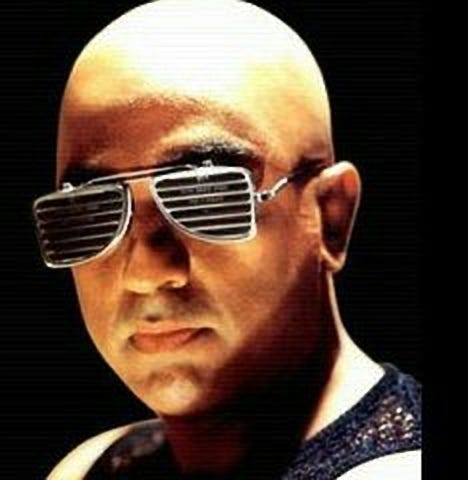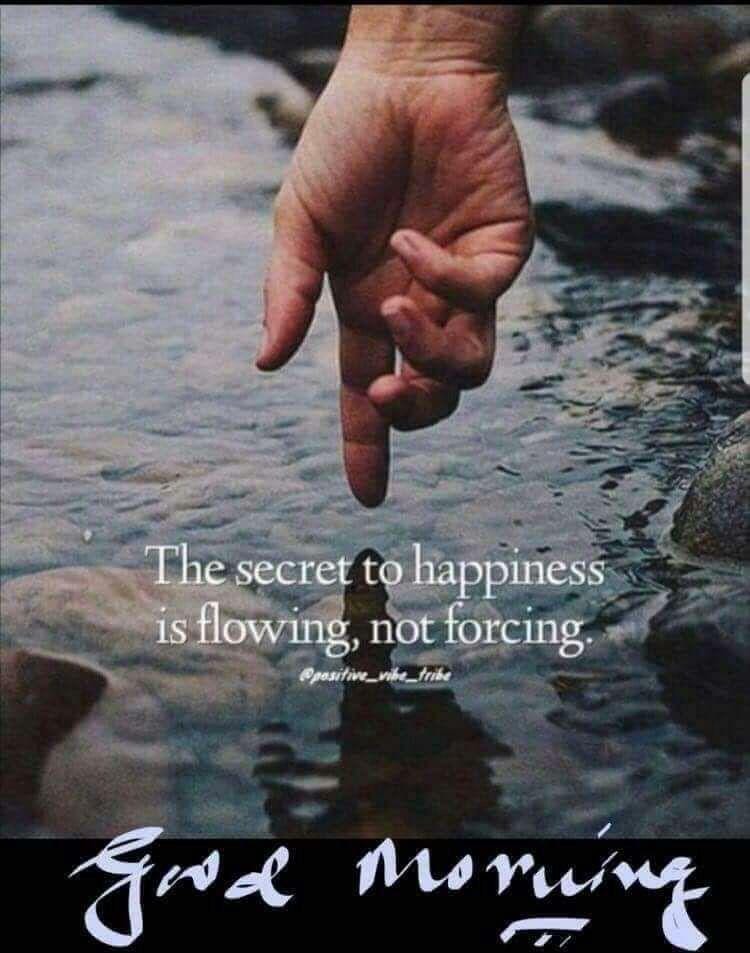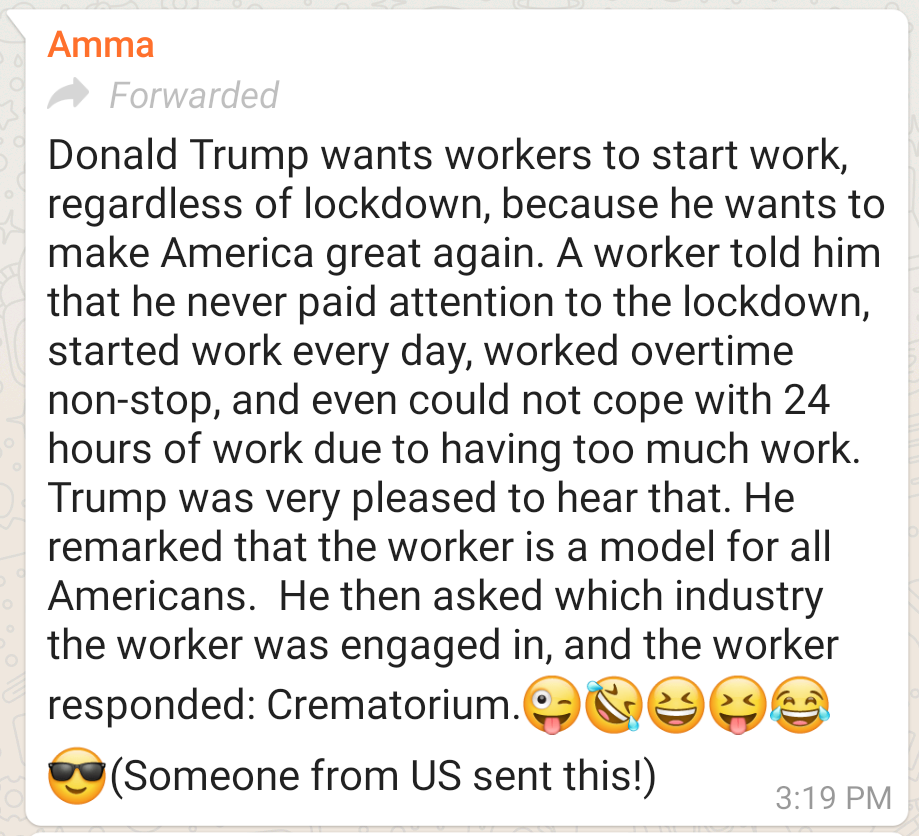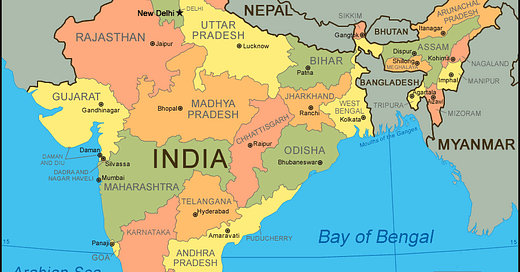india: large peninsular region, or unraveling kite?
official definition of "india" vs. my own, and an *inside scoop* of a small indian american household
I didn’t post anything last week—got busy and needed a break. I hope you didn’t miss me too much!
But now I’m back, better, and more ready than EVER to start tackling the big issues. Starting this week and continuing indefinitely, I want to talk more about language.
My parents left a country that’s younger than their parents to come here so let’s dive into it, ja?
India
Definition
Merriam-Webster: “large peninsular region that is usually referred to as a subcontinent and is located in southern Asia south of the Himalayas between the Bay of Bengal and the Arabian Sea; occupied by the countries India, Pakistan, and Bangladesh and formerly often considered to include Burma (but not Ceylon).”
Did you skip most of that? I don’t blame you. This definition is boring and reads like the setup portion of a Cold War-era board game.
It is also useless. “Bay of Bengal” and “Arabian Sea” mean very little to the geographically uninformed. So here, I’ve refined my personal definition of “India” to make things more clear.
Chuckry: A densely populated country in South Asia just north of the Equator. Its people come from various backgrounds and speak different languages. It kind of looks like a kite, whose thread is unraveling on the right side, wearing a hat (with disputed ownership). It is ripe with color, tradition, and mangoes.
Picture (supposedly worth 1000 words):

Etymology
The country’s name is a mistake given by would-be colonizers. First, Persian conquerors crossed the Sanskrit-named Sindhu River to get to India but mispronounced it as the “Indus” river. Alexander the (supposedly) Great further garbled this name when he learned of this land that he’d try to conquer. He and his Greek bros set their sights, called it “India,” and failed pathetically. The name spread through Europe and was reinforced when the idiot Columbus ravaged the wrong part of the world and again when the British seized the country.
Alternatives
Bharat: selected as the country’s official name in 1950.
Hindustan [outdated]: means “land of the Hindus” and is no longer used.
Not To Be Confused With…
Hindu
Hindi
Indigo
Indiana
Indianapolis
Indiana’s police
“In the yacht”
“In Die Hard”
Related
The name-conquering doesn’t end there either. Here’s a list of Indian cities and villages whose names the British changed because they couldn’t pronounce them:
Varanasi —> Benares
Chennai —> Madras
Bengaluru —> Bangalore
Mumbai —> Bombay
Kolkata —> Calcutta
It’s still happening, too! Less than 2 years ago, the Indian government (specifically the Hindu nationalist BJP party), renamed the city of Allahabad (a Muslim name originating from Mughal rulers in the 17th century) to Prayagraj in an attempt to selectively erase history.
Even my own name, “Chuckry,” is technically spelled “Chakri,” but my parents rewrote it so that Americans could pronounce it properly. (Parents tested this against their coworkers, who looked at “Chakri” and apparently guessed colorful nonsense like “SHAY-kruh,” “CHACK-ree,” “shuh-KRAI,” etc.)
Other
It’s a diverse country with 22 nationally recognized Indian languages, and 100s more that are unofficial. So remember that we don’t all speak Hindi! Don’t assume that we do (especially if you’re Indian—don’t send me Hindi memes pls).
And then to America
After moving to America, my parents developed their own connections to their Indian culture. They’re used to their own styles of humor, drama, wisdom, and comfort that they don’t find here.
Some of the obvious ones—travel, temple, restaurants, and even Indian television— crumbled during the pandemic (case in point: we were supposed to be in India last week for my dad’s birthday). The Indian cooking shows, game shows, and singing competitions they watched are gone, too. Some shows still air new episodes, but they’re mostly video chats of the hosts chilling at home with their families and bantering—too relatable.
Thankfully, some rituals have persisted.
Mine is simple and lethargic. I roll out of bed at around 8 every day. Sometimes 8:30, occasionally 9. It depends on the quality of my Twitter feed during my morning scroll. I head downstairs, make myself coffee and a yogurt bowl, and quietly let my thoughts compete. I spend most of my day reading, watching TV, and listening to music. It feels like I’ve reverted to my high school summer lifestyle.
My mom’s been awake since 5:30am. She scurries around the kitchen with her mask stretched under her chin. When the cooking aromas grow strong, she pulls it over her face and stirs the pot. Before I wake up, she’ll have already called her mom, who lives alone in Bengaluru, for their daily conversation. I hear her speak in Telugu and parse what few words I can in the back of my brain.
To me, Telugu is an energetic and loving language, filled with lots of “oo’s” and accented words. Full of playful teasing and exaggerated gestures. It could just be my family, though; it’s hard to tell where a language stops and personality begins.
She tells me to count to number of “swees” (high-pitched steam expulsions from the pressure cooker), then moves to the family room to relax and watch livestreamed Telugu spiritual lectures. If the California heat is tame, we’ll strap on our masks and go for a neighborhood walk afterwards. Later, before dinner, she’ll pray at the shrine she’s constructed with carefully arranged Hindu deities.
My dad stomps down the stairs so loudly that I fear he’ll one day fall through the carpet and floorboards into the crawl space and just live there indefinitely. If our timings coincide, he’ll announce one of my nicknames, stare into the fridge, tell me some story from his good old days that I’ve already heard, and stomp back up those poor aggravated stairs to work from his home office, a.k.a. our guest bedroom.
Later in the day, he’ll watch videos on YouTube—usually DIY home furnishing recommendations, painting tutorials, or Tamil comedy videos. He may take one small step towards a home project to which he’s attached, like extracting old laptop hard drives or setting up a garden in the backyard. At night, he calls his mom and sister.
Tamil culture is very important to him. He shaved his head years ago to resemble his favorite movie character (whose name is “Alavandaan,” which is both our WiFi name and actually translates to “Bezos of the East”):

They keep in touch with their college friends, who send them memes, jokes, conspiracy theories, and unsolicited advice, as is the standard for a WhatsApp group chat:


way too dramatic for the morning

uncomfortably toilet-themed

This one is true. The tree actually used to be an imperfect little sapling, yet it will eventually become the pages to some bucktoothed child’s Algebra workbook.

insensitive but also way too real
It isn’t just the nature of our group chats that differ—there just isn’t that much common ground between my parents and myself. Our tastes, styles, behaviors, values, and (obviously) ages differ. We spend our time differently. We react to the same events differently. We watch different shows and develop different obsessions. That’s probably how it is for most kids, and it’s magnified for immigrants’ kids.
But it occurs to me more and more often that we don’t always need to mesh. We don’t even need to be similar. Sure, there’s the obvious conclusion that we are separate people with our own brains and fears. They grew up in India and then came to America. I grew up entirely in America occasionally visited India, where I mostly stayed in my grandmothers’ apartments and read books. To stretch myself into my parents’ comfort zone is unfair to everybody—to myself, to them, to the world. It’s like rigging an experiment to produce results you expect.
Many use the word “diaspora” (another word that I love) to describe our situation of being scattered around the world, far away from our origins. Call it whatever you like. I try to balance that perspective. My origins are my parents, who are not so far. Every day, they bring me India, America, and distance between them. It’s who they are. To compare myself to anything else feels like an oversight. It’s tempting for children of immigrants to say that they’re in both the new world and the old one. “I’m American, and I’m also Indian.” But actually, while we love both, we create a new world. “I’m Indian American.”
Now we just need to put all of the above in the dictionary.
Other Cool Things!
Justice for Breonna. Breonna Taylor’s killers are still walking free. Please take moment to sign the petition, call and email institutions in charge, and spread the word.
Desi Voices. The creative writing workshop that I’ve been running for Indian American kids is now online! Check it out to see what they wrote about!
The Art of Fiction. In a strange mood, I decided to improve my concept of fiction. I picked up this old book prescribed for a college creative writing class but never referred to, and I enjoyed all of it.
Mr. Robot. Anyone else watch this show? It’s addicting, but I’ve gotta say the plot’s more scattered than a stats quiz. It’s incredibly and eerily timely, though—it’s about a man who wears one black hoodie all the time and hacks the world’s biggest fattest juiciest tech company to start a revolution. Anti-capitalism commentary ensues.
Beckon Ice Cream. Some real good lactose-free stuff.




Incredible writing! the descriptions of your parents are lovely.
these WhatsApp memes are incredible